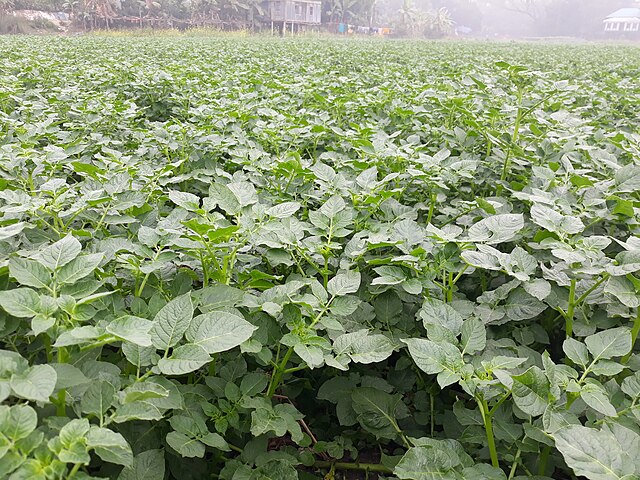Farmers in Dijanpur, northern Bangladesh are sowing early potatoes, with seeds extremely cheap but fertilizer rates up due to syndication.
Despite enjoying a fraction of potato seed costs afloat ongoing national potato price slump, growers are courting currently dear fertilizer.
By October 19, 2025, TSP and Urea were costing 1,350 Taka ($11.06) apiece, versus the government’s 1,250 Taka ($10.24), per the Dhaka Tribune.
Domestic DAP fertilizer was at 1,050 Taka ($8.60) versus the governmental 950 Taka ($7.78) while MOP surpassed the governmental by 100 Taka ($0.82).
Still, 11,000 hectares of potato fields across Dijanpur are busy absorbing early sowed varieties, namely Bina-7, Stariz and Sunshine.
Potato Seed Rates Fall Sevenfold
The seed rate has meanwhile plummeted to 15-16 Taka ($0.13) per kg, 7 times below 2024’s market maximum at 110 Taka (0.9)/kg.
These rates are also about 4 times below last year’s government’s minimum recommended price of $57 Taka ($0.47)/kg.
But even as they enjoy throw away seed offers, farmers with old reserves for consumption are commiserating acute market price collapses.
By mid-October 2025, wholesale potatoes in Bangladesh were selling at 8 Taka ($0.066)/kg, below half the production expenditure.
60-kg sacks were selling at 480 Taka ($3.93), a sliver of the nearly 1,000 Taka ($8.19) it takes to produce them.
The withholding of reserves by producers adamant to out-wait price collapse has sparked speculations of things getting worse.
Excess production is to blame: Bangladesh reaped some 11.5 million tonnes of potatoes in the 2024 season versus local consumption volume at 9 million tonnes.
If tit comes to tat, cold storage operators will be the eventual profiteers by November 15. This is the date when farmers finally relinquish their withheld reserves after 6 months of room temperature storage.
Earlier this August, the Ministry of Agriculture had scrambled to set the cold storage rates at 22 Taka ($0.18) a kg.
Ongoing sowing will meantime nurture a potato crop by late December with a forecast yield rate at above 140 maunds (37 kg)/acre.
So, fertilizer cost hikes and old potato crop bearishness are variously affecting early season potatoes in Bangladesh for good or for worse. But have things been always like this in previous seasons? The statistics below attempt an answer to the question.
Bangladesh Potatoes Statistics
Since their introduction by the British colonial rulers in Bengal in the 1770s, potatoes have become a staple here. From that time, the crop has fawned tens of varieties from Alouette to Sunshine, to name but two.
Bangladesh averages 10.1 million tonnes of potatoes a year, as of 2022, the 7th highest output worldwide. Only Germany, the U.S., Russia, Ukraine, India and China in ascending order of production excel that of the Bengal country. Here is a tabulation of how output has fared in the early 2020s, courtesy the FAOSTAT:
| Season | Total Harvest [tonnes] | Harvest Area [Ha] | Yield Rate [t/Ha] |
| 2022-23 | 10,431,736 | 455,523 | 22.9 |
| 2021-22 | 10,144,835 | 464,011 | 21.9 |
| 2020-21 | 9,887,242 | 468,699 | 21.1 |
| 2019-20 | 9,606,000 | 461,351 | 20.8 |
| 2018-19 | 9,655,082 | 468,395 | 20.6 |
From the above figure, it is apparent that annual output and productivity rose in the 5-year period even as acreage fluctuated. Has this affected prices and consumption? The below section answers the question.
How much potatoes do people in Bangladesh eat?
As of 2025, Bangladesh was consuming 9 million tonnes of potatoes, leaving a surplus of 1 to 2.5 million for export. According to the Helgi Library, the per capita consumption is at 48.6 kg per person per year, as of 2021, the 50th highest. The highest historical per capita consumption was in 2018 at 50.9 kg while the lowest in 1964 at 4.34 kg.
Does production affect potato rates in Bangladesh?
Whenever there is surplus, potato wholesale prices in Bangladesh crash drastically. In early October 2025, for instance, an annual production surplus of 12% plummeted prices by 61%, year-on-year. As of October 5, 2025, retail rates touched 18 to 25 Taka ($0.17-0.24) a kg, versus 50 to 60 Taka (0.46-0.55) a year back. The same applies to wholesale rates at 8-10 Taka (0.066-0.072) a kg, 7 times down from a year back.
